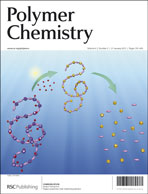Cationic long-chain hyperbranched poly(ethylene glycol)s with low charge density for gene delivery†
Abstract
A series of cationic long-chain hyperbranched poly(ethylene glycol)s (HPEGs) with low charge density were designed and synthesized. Through one-pot Michael-addition reaction of poly(ethylene glycol) diacrylate and 2,2′-(ethylenedioxy)bis(ethylamine), cationic long-chain HPEGs with different degrees of branching were obtained, which was confirmed by 1D and 2D NMR, FTIR, DSC and SEC-MALLS. Different from the traditional surface PEGylation strategy, the backbone of HPEGs consisted of oligo-ethylene glycol and biodegradable ester connections. Therefore, HPEGs showed low cytotoxicity. Due to the existence of low charge density in the polymeric backbone, the cationic HPEGs could form negatively charged loose polyplexes with plasmid DNA (pDNA), which was confirmed by zeta-potential measurements, agarose gel electrophoresis, circular dichroism and atomic force microscopy. The fluorescence microscopic studies demonstrated that the HPEG–pDNA polyplexes with low negative charges could be efficiently internalized by cells through endocytosis, exhibiting high transfection efficiency. By combining the advantages of a long-chain hyperbranched structure and PEG, cationic HPEGs provide a new opportunity for developing safe and efficient gene vectors.


 Please wait while we load your content...
Please wait while we load your content...